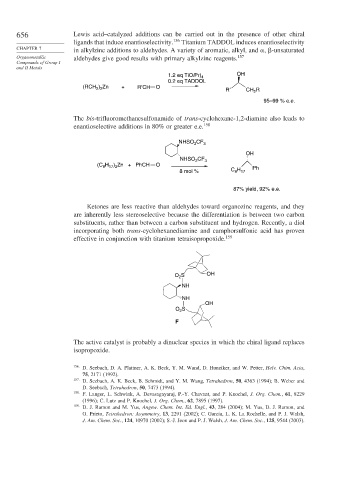Page 681 - Advanced Organic Chemistry Part B - Reactions & Synthesis
P. 681
656 Lewis acid–catalyzed additions can be carried out in the presence of other chiral
ligands that induce enantioselectivity. 156 Titanium TADDOL induces enantioselectivity
CHAPTER 7
in alkylzinc additions to aldehydes. A variety of aromatic, alkyl, and
,
-unsaturated
Organometallic aldehydes give good results with primary alkylzinc reagents. 157
Compounds of Group I
and II Metals
OH
1.2 eq TiOiPr) 4
0.2 eq TADDOL
(RCH ) Zn + R′CH O R′ CH R
2 2
2
95–99 % e.e.
The bis-trifluoromethanesulfonamide of trans-cyclohexane-1,2-diamine also leads to
enantioselective additions in 80% or greater e.e. 158
NHSO CF 3
2
OH
NHSO CF 3
2
(C H ) Zn + PhCH O
8 17 2
8 mol % C H Ph
8 17
87% yield, 92% e.e.
Ketones are less reactive than aldehydes toward organozinc reagents, and they
are inherently less stereoselective because the differentiation is between two carbon
substituents, rather than between a carbon substituent and hydrogen. Recently, a diol
incorporating both trans-cyclohexanediamine and camphorsulfonic acid has proven
effective in conjunction with titanium tetraisopropoxide. 159
O S OH
2
NH
NH
OH
O S
2
F
The active catalyst is probably a dinuclear species in which the chiral ligand replaces
isopropoxide.
156
D. Seebach, D. A. Plattner, A. K. Beck, Y. M. Wand, D. Hunziker, and W. Petter, Helv. Chim. Acta,
75, 2171 (1992).
157 D. Seebach, A. K. Beck, B. Schmidt, and Y. M. Wang, Tetrahedron, 50, 4363 (1994); B. Weber and
D. Seebach, Tetrahedron, 50, 7473 (1994).
158 F. Langer, L. Schwink, A. Devasagayaraj, P.-Y. Chavant, and P. Knochel, J. Org. Chem., 61, 8229
(1996); C. Lutz and P. Knochel, J. Org. Chem., 62, 7895 (1997).
159
D. J. Ramon and M. Yus, Angew. Chem. Int. Ed. Engl., 43, 284 (2004); M. Yus, D. J. Ramon, and
O. Prieto, Tetrahedron: Asymmetry, 13, 2291 (2002); C. Garcia, L. K. La Rochelle, and P. J. Walsh,
J. Am. Chem. Soc., 124, 10970 (2002); S.-J. Jeon and P. J. Walsh, J. Am. Chem. Soc., 125, 9544 (2003).

